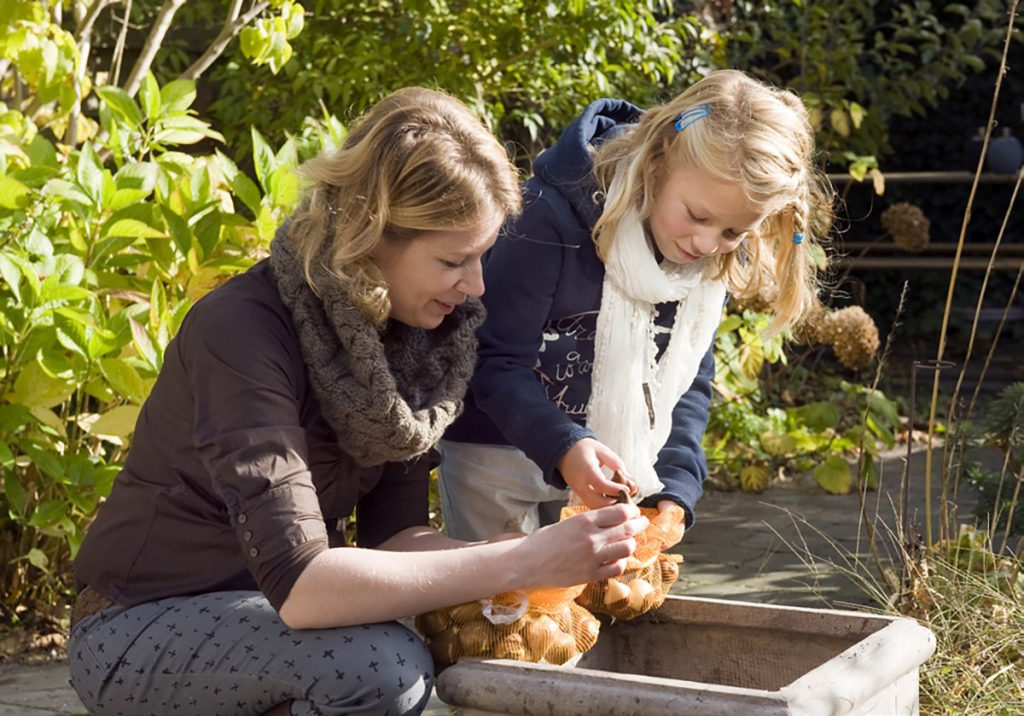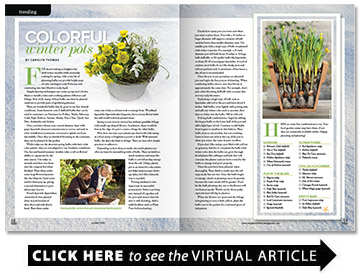Colorful Winter Pots
There might not be anything flowering outside, but that doesn’t mean winter has to be drab
BY Carolyn Thomas

For those looking to brighten the drab winter months while anxiously waiting for spring, with a tiny bit of planning bulbs can provide bright pops of color starting in early February and continuing into late March to early April.
Simple layering techniques can create a potpourri of color blasts or install a calm and soothing palette of flowers and foliage. Best of all, many of these bulbs can then be planted outdoors to provide years of gardening pleasure.
There are wonderful bulbs that do great in our hot, humid conditions. Some fantastic zone 8 daffodil bulbs that can be used in containers are Narcissus Ice Follies, Thalia, February Gold, Pipit, Kedron, Salome, Manly, Tete a Tete, Quail, Sun Disc, Avalanche and Avalon.
Once you have chosen your central element, layer with grape hyacinth (muscari armeniacum) or crocus and tuck in a few windflowers (anemone coronaria) to splash out from the middle. Once they are finished blooming in the container, they can be planted in the garden.
While tulips are the showiest spring bulbs with their wide color palette, they are not adapted to our Southern conditions. Our hot and humid summer weather takes a toll on flowers’ ability to regenerate for the next season. Use tulips as annuals and then toss them into the compost bin when finished. Plant them under some large flowered pansies like the Majestic Giant series and let them pop up, giving a second dimension to your plantscape in pots.
French hyacinth (hyacinthus orientalis) do best planted alone in pots because of their short and wide flower head. Plant them under some cute violas as a framework to emerge from. Woodland hyacinths (hyacinthoides hispanica) have a looser flower habit but still would look best planted alone.
Spring crocus (crocus vernus) has delicate grasslike foliage with small cup-shaped flowers. In planters, these would do best at the edge of a pot to create a fringe for other bulbs.
How does one start a pot plantscape that looks welcoming at a front entry or brightens a porch or deck? With seasonal bulbs, the sky’s the limit in design. There are just a few simple practices to adhere to.
Depending on how they are made, decorative planters are often an issue for successful growth of bulbs. They can hold too much moisture and cause the bulbs to rot before they emerge from the soil. Using a plastic pot as an insert for a decorative pot helps ensure proper drainage (plus, isn’t this a fantastic way to recycle?).
Potting medium is also important in successful preparation. Select a potting mix instead of a garden soil for pots and ensure that the mix is well draining. Add a mild fertilizer such as Plant Tone before planting.
Decide how many pots you want and where you want to place them. Pots with a 16 inches or larger diameter will support a mixture of bulb varieties better than smaller diameter ones. Use smaller pots with a single type of bulb overplanted with violas or pansies. For example, a 16-inch diameter pot will hold about 30 tulips or 15 large bulb daffodils, or 30 smaller bulbs like hyacinths, or about 50-60 crocus/grape hyacinths. A word of caution: most bulbs do not like shady spots and will not perform well. A minimum of four hours a day of sun is recommended.
Once the pot or pot groupings are planned, you can begin the fun process of planting. When combining bulbs, choose ones that bloom at approximately the same time. For example, don’t pair a late blooming daffodil with crocuses that are very early bloomers.
If planting a single type of bulb such as hyacinths, add soil to the pot and leave about 4 inches. Add bulbs, cover lightly with potting mix, and add any winter color such as pansies, dianthus or violas over the bulbs. Fill in with soil.
If doing bulb combinations, begin by adding the largest bulbs to the lower half of the pot and add a light layer of soil. Continue to add bulbs from largest to smallest in this fashion. Place bulbs close to one another, but not touching. Leave at least one inch at the top of the pot so when you water, the water doesn’t overflow.
If you don’t like seeing a pot filled with soil but no greenery, feel free to overplant the bulbs with winter color that the bulbs can grow through. Avoid plants like cabbages and kale that will consume the planter and not leave room for the bulbs to emerge and grow properly.
Once the pots have been planted, water thoroughly. Then check to make sure the soil stays moist but not wet. Once the bulbs begin to emerge, check on plantings more frequently because the water needs will be greater. Don’t let the bulb plantings dry out or the flowers will not form properly. Watch out for those pesky squirrels that will dig in planters.
When the flowers are spent and the foliage is beginning to turn a little yellow, plant the bulbs out in the garden for continued years of enjoyment.
Here are some fun combinations to try. Your local garden center may have these, if not they are commonly available online. Happy planning and planting!
Sunshine
- February Gold daffodil
- Tete a Tete daffodil
- Sun Disc daffodil
- Golden Apeldoorn tulip
- Yellow Mammoth crocus
- City of Harlem hyacinth
Playin’ the Blues
- Negrita tulip
- Purple Pride tulip
- Shirley tulip
- Delft Blue hyacinth
- Blue Jacket hyacinth
- Red De Caen anemone
- Lord Lieutenant anemone
- Grape hyacinth
- Spanish bluebells
Flower Power
- Red Apeldoorn tulip
- Kedron daffodil
- Blue De Caen anemone
- Pickwick crocus
Cool as a Cucumber
- Thalia daffodil
- Maureen tulip
- Mt. Everest anemone
- Joan of Arc crocus
- Carnegie French hyacinth
- White Magic grape hyacinth
Pretty Baby
- Pink Impression tulip
- Ice Follies daffodil
- Delft Blue hyacinth
- Mt. Everest anemone
